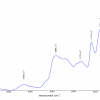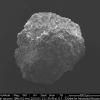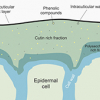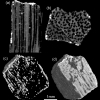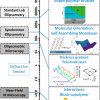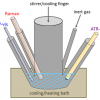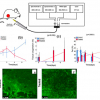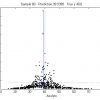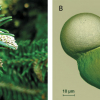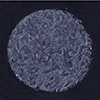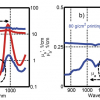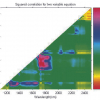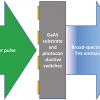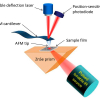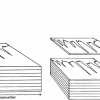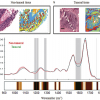Articles
Benchtop mid-IR and NIR as well as portable NIR instruments are used for quick and non-invasive quality control of this traditional Chinese medicine. Adulterations could be detected, as well as the raw herbs and different sources of the Si-Wu-Tang. The success of the mobile NIR instrument is particularly interesting due to the growing interest in such technology for its ease-of-use and cost.
Several earthworm species secrete very small granules of calcium carbonate, and the authors think these are involved in pH regulation. These granules contain different polymorphs of calcium carbonate, including the amorphous form which is very unstable in the laboratory. To investigate this they have FT-IR spectroscopy and mapping, and are continuing this work with Ca XANES.
Much of the exterior surface of plants is covered by the cuticle. This plays a vital role in protecting the plant from water loss, attack by pests and pathogens and damage from UV radiation. Infrared spectroscopy is very useful in characterising cuticles, as we learn in “Infrared spectroscopy as a tool to study plant cuticles” by José Heredia-Guerrero, José Benítez, Eva Domínguez, Ilker Bayer, Roberto Cingolani, Athanassia Athanassioua and Antonio Heredia. The authors point out that, whilst still in its early stages, infrared spectroscopy has provided valuable information about the functional groups, chemical structure and arrangement and interactions of plant cuticle components.
Dates and fates of pyrogenic carbon: using spectroscopy to understand a “missing” global carbon sink
Research into climate change takes many directions, but storing carbon or understanding its release from stores is extremely important. Pyrogenic carbon comes from the incomplete burning of biomass, and can be natural, e.g. wild fires, or man-made, e.g. the production of charcoal. The authors describe the uses of a range of spectroscopy techniques to understand the molecular structure of pyrogenic carbon and its role in the global carbon cycle.
In the Tony Davies Column, we learn about “Automated detection of counterfeit drugs using multimodal spectroscopy and advanced web-based software platforms”. With the increase in trafficking of counterfeit medicines and other products, there is a need for definitive results from an on-site analyser useable by customs officers. The German authorities have commissioned the development of a multi-modal, transportable inspection system, including intelligent data processing and evaluation, for fast spectroscopic recognition of illicit drugs and counterfeit medicines. This is described in the column.
Mark Tobin and colleagues describe “Fourier transform infrared spectroscopy and imaging of dragonfly, damselfly and cicada wing membranes”. Insects and plants have evolved highly specialised surfaces such as being highly water repellent or superhydrophobic, which also confers self cleaning properties. This is of interest to materials scientists to help in the development of manufactured materials with similar properties. High spatial resolution FT-IR spectroscopy and imaging provide useful information about the complex chemical patterning that contributes to this functionality.
The authors describe “Infrared mapping spectroscopic ellipsometry”. Recent developments in fundamental and materials research have increased the value of mapping techniques such as ellipsometry. IR ellipsometry, since it operates in the mid-IR fingerprint region, provides complementary information on composition, structural properties and interactions
In situ spectroscopic methods such as infrared, Raman and UV/vis spectroscopy are powerful tools to gain insight into reaction mechanisms and catalyst actions in homogeneously catalysed reactions. These methods and combinations of them offer great potential for the real-time monitoring of reactions in the liquid phase, for mechanistic studies as well as process control and kinetics.
“Optical spectroscopy in therapy response monitoring: an awakening giant” by Arja Kullaa, Surya Singh, Jopi Mikkonen and Arto Koistinen looks at the important advances made by optical spectroscopy techniques, such as diffuse optical spectroscopic imaging (DOSI), Raman, diffuse reflectance and fluorescence spectroscopy, in changing how cancer is managed in patients. The ability to repeatedly monitor tumour dynamics to see how effective a particular treatment has been has enormous potential for us all.
This is Tony’s last column for Spectroscopy Europe. It is explores an idea that he has been developing for over 30 years, although as Tony points out the story starts around 3500 years ago.
“Shedding light on plant biology by Fourier transform infrared spectroscopy of pollen” by Boris Zimmermann and Achim Kohler. Currently, pollen identification is mostly done under a light microscope. FT-IR spectroscopy of pollen grains provides rapid and simple identification of pollen, with the added benefit of providing environmental information.
Mid-infrared spectroscopic imaging is a rapidly emerging technique in biomedical research and clinical diagnostics that takes advantage of the unique molecular fingerprint of cells, tissue and biofluids to provide a rich biochemical image without the need for staining. Spectroscopic analysis allows for the objective classification of biological material at a molecular level.1 This “label free” molecular imaging technique has been applied to histology, cytology, surgical pathology, microbiology and stem cell research, and can be used to detect subtle changes to the genome, proteome and metabolome.2–4
The analysis of turbid samples is increasingly important, not least due to their widespread occurrence in natural samples. Dmitry Khoptyar, Sören Johansson, Staffan Strömblad and Stefan Andersson-Engels show “Broadband photon time-of-flight spectroscopy as a prospective tool in biomedicine and industrial process and quality control”. The authors describe their recent development of a broadband spectrometer for evaluation of absorption and scattering spectra of very diverse turbid materials in the visible and close-near infrared (NIR) regions and its application with milk, cheese and paper samples.
“Spectral database for postage stamps by means of FT-IR spectroscopy” by Eleonora Imperio, Gabriele Giancane and Ludovico Valli will be of great interest. As well as helping to detect forgeries, FT-IR has been used to create a database which also charts the history of the technology used to create stamps. Quite rightly, they are considered by many to be works of art.
Tony (A.M.C.) Davies looks at Multiple Linear Regression (MLR) this issue, as well as expressing his opinions about Principal Components Regression (PCR) and Partial Least-Squares (PLS).
Tony Davies explains “Terahertz Spectroscopy” and describes some new and interesting applications
The authors give us a “Review of nanoscale infrared spectroscopy applications to energy related materials”. Fuel cells, photovoltaics and specialised polymers for fracking are all considered.
“From lake ecology to biofuels—applications of Fourier transform infrared spectroscopy to algal research” is the topic of Andrew Dean, Jon Pittman and David Sigee. Algae are essential for our continued live on Earth, and FT-IR spectroscopy can increase our understanding of their physiology and biotech potential.
Tony (A.M.C.) continues down the last furlong of his series of Tony Davies Column articles. This issue, he considers principal component analysis (PCA). Using research recently published in the Journal of Near Infrared Spectroscopy, he explains that PCA is a very useful tool but it will not solve all our problems. Two old articles on PCA, including Tony’s concept of the “Data Cake” have been added to the website, are referenced in Tony’s article and can be freely downloaded by readers.
This article describes an application of spectral imaging for the differentiation of tumour and normal cells. The authors also introduce the concept of a spectral barcode, which has had success with some tissues and has potential in others.

